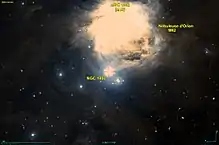| NGC 1980 | |
|---|---|
 DSS image of the open cluster NGC 1980, located on the southern tip of the Orion Nebula, and the nebula NGC 1982 (M43) located on its northern edge | |
| Observation data (J2000.0 epoch) | |
| Right ascension | 05h 25m 26.0s[1] |
| Declination | −05° 54′ 36″[1] |
| Distance | 1793 ly[2] (550 pc[2]) |
| Apparent magnitude (V) | 2.5[3] |
| Apparent dimensions (V) | 14.00 x 14.0[4] |
| Physical characteristics | |
| Estimated age | 4.7 million |
| Other designations | Lower Sword,[5] Collinder 72, OCL 529, WH V 31 |
| Associations | |
| Constellation | Orion |

The Orion Nebula M42 with NGC 1980 on the right (right is south)
NGC 1980 (also known as OCL 529, Collinder 72 and The Lost Jewel of Orion[6]) is a young open cluster associated with an emission nebula in the constellation Orion. It was discovered by William Herschel on 31 January 1786.[7] Its apparent size is 14 × 14 arc minutes and it is located around the star Iota Orionis on the southern tip of the Orion constellation.[4][8]
Herschel made his first observation of the cluster which was called WH V 31 on 31 January 1786, but he possibly observed it during his studies of double stars on 20 September 1783.[7]
References
- 1 2 "NED results for object NGC 1980*". NED. Retrieved 27 November 2017.
- 1 2 "The open cluster NGC 1980". In the Sky. Retrieved 27 November 2017.
- ↑ "ngc 1980". sim-id. Retrieved 2020-06-07.
{{cite web}}: Check|url=value (help) - 1 2 "Object: NGC 1980 (*)". SEDS. Retrieved 27 November 2017.
- ↑ "NGc 1980". sim-id. Retrieved 2020-06-10.
- ↑ O'Meara, Stephen James (2007). Deep-Sky Companions: Hidden Treasures. Cambridge University Press. pp. 155–157. ISBN 9780521837040.
- 1 2 "NGC 1980 (= OCL 529), the ί Orionis Nebula". cseligman. Retrieved 27 November 2017.
- ↑ "Star Cluster Near Orion Nebula Revealed in Telescope Views". Space.com. November 14, 2012. Retrieved 27 November 2017.
This article is issued from Wikipedia. The text is licensed under Creative Commons - Attribution - Sharealike. Additional terms may apply for the media files.